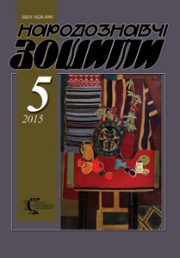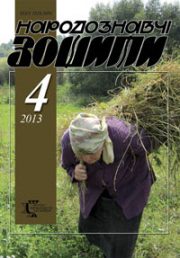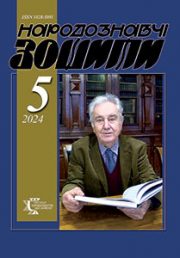The Ethnology Notebooks. 2024. № 2 (182), 295—316
UDK [391.7:746.5.011.26.02](=161.2:477.83/.86)”19″(091)
DOI https://doi.org/10.15407/nz2025.02.295
FEDORCHUK Olena
- ORCID ID: https://orcid.org/0000-0002-4724-3566
- Doctor of History (Dr. Sci.), Leading Researcher,
- The Ethnology Institute of National Academy of Sciences of Ukraine,
- Historical Ethnology Department,
- 15, Svobody Avenue, 79000, Lviv, Ukraine,
- Contacts: e-mail: olena-fedorchuk@ukr.net
Abstract. The article is devoted to the beaded cotillion, which was a common element of Eastern Galicia, Northern Bukovyna and Transcarpathia traditional Ukrainian clothing during the first part of the XX century — the period of the liberation struggle of Ukrainians for their independence. The proposed article examines technical and artistic means that were used to construct the compositions which made the cotillion a popular work of folk art of that time.
As a result of the analysis of the technological features of the decoration, it was established that Ukrainians performed cotillions using beadweaving, loomweaving and embroidery techniques. The dominant technique was bead loomweaving, which made it possible to create motifs of geometric and geometrized forms. An overview of the cotillion’s compositional solutions reveals a diverse repertory that captures the psychological and emotional climate of Ukrainian society in the early 1900s. National symbols played a significant role in this repertory as a means of bringing Ukrainian society together around the concept of state independence.
The relevance of the article is due to the current interest in the Ukrainian cotillion as a socially demanded work of folk art during the liberation struggle of Ukrainians. This renewed interest was provoked by current russian aggression, which actualized the patriotic sentiments of Ukrainian society, reviving its interest in consonant historical realities, in particular, in patriotic reflections of folk art of the first half of the XX century.
The object of the study is the beaded cotillion of Ukrainians as an ethno-artistic phenomenon of the first half of the XX century, and the subject of the study is its technological, thematic, and artistic and stylistic features.
The scientific novelty of the work lies in its meticulous visualization and comprehensive analysis of the technical and artistic characteristics of the Ukrainian cotillion of the first half of the XX century, as well as its compositional solutions’ semantics.
The research methodology is based on a systemic-historical approach and such methods as photographing artifacts, interviewing and audio-recording narratives, scientific analysis, analytical interpretation and historical reconstruction.
The source base of the research consisted of visual and verbal information about the bead cotillion, gathered during work in state museums and ethnographic expeditions as well as received from scientific colleagues and private collectors.
It is predicted that the analytical materials and illustrations collected in this article will contribute to the comprehension and revival of the cotillion as a unique ethno-artistic phenomenon.
Keywords: Ukraine, folk art, bead cotillion, national symbols, coat of arms, flag.
Received 7.04.2025
REFERENCES
- Fedorchuk, O. (2024). The beaded cotillion as an actual artifact of Ukrainian culture: genesis and peculiarities of use. In: The Ethnology Notebooks, 3 (177), 617—630. DOI: https://doi.org/10.15407/ [in Ukrainian].
- Kozholyanko, H. (1999). Ethnography of Bukovyna: in 3 vol. (Vol. 1). Chernivtsi [in Ukrainian].
- Kozholyanko, G. (2010). Complementary elements of the traditional folk costume of Bukovyna Ukrainians. In: Folk art and ethnology, 1, 57—66 [in Ukrainian].
- Pavlyuk, A. (2000). Beaded Adornments in the collections of the Chernivtsi Museum of Folk Architecture and Life. In: Bukovyna is my native region: materials of the historical and local history conference of young researchers, students and scientists (Pp. 105—107). Chernivtsi [in Ukrainian].
- Fedynchuk, O. (2018). Neck and chest men’s and women’s beaded jewelry of Northern Bukovyna. In: Bulletin of Lviv National Academy of Arts (Issue 35, pp. 124—139) [in Ukrainian].
- Pakholko, S., & Martin, O. (2006). Cotillion as a talisman insignia in Ukrainian military formations of the period of the national liberation struggle of 1916—1950. In: Numismatics and Phaleristics, 4, 22—25 [in Ukrainian].
- Marusyk, N. (2017). Ancient Bukovinian beadwork. Kyiv [in Ukrainian].
- Vyatrovych, V., & others (Ed.) (2006). Army of the Immortals. Rebel photos (3rd ed.). Lviv [in Ukrainian].
- Klyashtorna, N. (Ed.). (2013). Scattered over the steppes. Photographic materials from the lives of residents of western Boykos in their native lands as well as after resettlement. Ivano-Frankivsk [in Ukrainian].
- Svyontek, I. (2013). Pokuttya region embroidery of the Carpathians. The art of geometric ornament and coloring. Album 1. Lviv [in Ukrainian].
- Оplestilova, H., & Babka, L. (2014). The Vanished World of Subcarpathian Ruthenia in the Photographs of Rudolf Hůlka (1887—1961). Praha [in Czech].
- Velikochiy, V. (Ed.) (2014). Ages of past strongholds: Horodenka region in old documents and photographs. Ivano-Frankivsk [in Ukrainian].
- Svarnyk, I. (Ed.) (2004). Small Photo Encyclopedia of Ukrainian Sich Riflemen. Lviv [in Ukrainian].
- Legion of Ukrainian Sich Riflemen. Photo archive. Retrieved from: https://www.legionukrainiansichriflemen.com (Last accessed: 19.03.2025) [in Ukrainian].
- Fedorchuk, O. (2003). Typology of Ukrainian folk adornments of beads. In: The Ethnology Notebooks, 5—6 (53—54), 702—719 [in Ukrainian].
- Fedorchuk, O. (2007). Ukrainian Folk Beaded Adornments. Lviv [in Ukrainian].
- Fedorchuk, O. (2012). Beads in the decoration of traditional Ukrainian clothing (issue of typology). In: The Ethnology Notebooks, 3 (105), 452—468 [in Ukrainian].
- Fedorchuk, O. (2019). Cotillion. In: Western Ukrainian People’s Republic 1918—1923: Encyclopedia: in 4 vol. (Vol. ІІ, pp. 301—302). Ivano-Frankivsk [in Ukrainian].
- Fedorchuk, O. (2021). The Tradition of Beaded Decoration in the Ukrainian Folk Costume (Based on the Materials from Western Regions of Ukraine). Lviv [in Ukrainian].
- Fedorchuk, O. (2024). National symbolism in the compositions of Ukrainian cotillions of the first half of the XX century. In: Authentication and Conservation of Cultural Heritage. Research and Technique. Supplement: Materials of the reports of the International Scientific Conference «Yesterday’s cultural heritage — implications for the development of tomorrow’s sustainable society» (Vol. VIII, pp. 70—81) [in Ukrainian].
- Fedorchuk, O. (1999). The protective magic of bead jewelry. In: Art History: Scientific Collection (Pp. 139—152). Lviv [in Ukrainian].
- Pastukh, N. (2013). The image of animals in Ukrainian folklore: the zozulya. Lviv [in Ukrainian].
- Selivachov, M. (2005). Lexicon of Ukrainian Ornamentation (iconography, nomination, stylistics, typology). Kyiv [in Ukrainian].
- Shchybria, V., Fedorchuk, O., & Voroniuk, L. (Ed.). (2025). Patsiorky, tsiatky, coralyky. Seed bead jewelry from the Volodymyr Shchybria`s collection. Kyiv [in Ukrainian and English].
- Zapasko, Ya. (1995). Monuments of Book Art: Ukrainian Manuscript Book. Lviv [in Ukrainian].
- «Izbornyk Svyatoslava» is the first Old Ruthenian Google. SlovOpys (WordDescription). Retrieved from: https://slovopys.kubg.edu.ua/izbornyk-sviatoslava-pershyi-davnoruskyi-huhl/ (Last accessed: 19.03.2025) [in Ukrainian].
- Nesterenko, P.V. (2010). Expertise of objects and attributes: heraldry. Kyiv [in Ukrainian].
- Mazepa, O. (2013). Issues of heraldic terminology in the publication of «Notes» of the Ukrainian Genealogical and Heraldic Society In Sphragistic Yearbook (Issue 4. Pp. 26—53) [in Ukrainian].
- Narizhnyi, K.G. (1977). The Living World of Heraldry. Animals and Plants in State Symbolism. Kyiv [in Ukrainian].
- Panchenko, V. (1996). Coat of arms of cities of Ukraine. Kyiv; New York [in Ukrainian].
- Bukovina carpet. Chernivtsi Regional Museum of Folk Architecture and Life. Retrieved from: https://eu.zonerama.com/eksponati/Photo/7174745/262092595 (Last accessed: 19.03.2025) [in Ukrainian].
- Zhayvoronok, V. (2018). Anthology of Signs of Ukrainian Ethnoculture: Dictionary-Reference. Kyiv [in Ukrainian].
- Pavlutsky, G. (1927). History of Ukrainian Ornament. Kyiv [in Ukrainian].
- Voroniuk, L., & Shchybria, V. (Ed.). (2023). Imperishable: Ukrainian State Symbols in Folk Embroidery and Weaving: Album. Kyiv [in Ukrainian].
- Grechylo, A. On the question of the national flag. Retrieved from: https://archive.ph/qYgnS#selection-209.0-213.35 (Last accessed: 19.03.2025) [in Ukrainian].
- Gai-Nyzhnyk, P.P. (2018). The establishment of the Trident in the official symbols of the Ukrainian People’s Republic and the Ukrainian State during the time of the Central Rada and the Hetmanate (1917—1918 years). In: Gilea: scientific bulletin. Historical sciences, 4 (131), 21—29 [in Ukrainian].
- Ishchenko, Ya.O. (2008) Heraldic language and terminology, basic prescriptions and scientific concepts. In: Ukrainian Historical Journal, 3, 162—176 [in Ukrainian].
- Chmyr, M.V. (1999). Military awards in the Western Ukrainian People’s Republic (1918—1919). In: Ukrainian Historical Journal, 5, 50—56 [in Ukrainian].
- Vedeneev, D.V. (2010). Awards of the Ukrainian Insurgent Army. Retrieved from: http://www.history.org.ua/?termin=Nahorody_UPA (Last accessed: 19.03.2025) [in Ukrainian].
- Popelyuk, R. «Sokil»: trained the body, but educated the Ukrainian spirit. Local history (06.04.2021). Retrieved from: https://localhistory.org.ua/texts/statti/sokil-trenuvav-tilo-a-vikhovuvav-ukrayinskii-dukh/ (Last accessed: 19.03.2025) [in Ukrainian].






